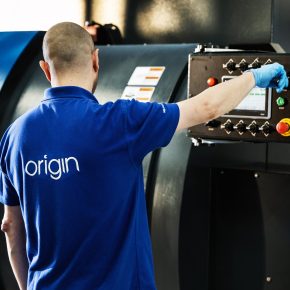
GDHV: Fan coil refurbishment for improved operational efficiency
What are the key components to consider for fan coil refurbishment that could lead to improved operational efficiencies? Glen Dimplex take a look…
There are several key components to consider when improving the operational efficiency of existing fan coil units. These can include fan motors, actuators, filters, and controllers. The age and condition of fan coil units can have a significant impact on the efficiency of cooling, heating, ventilation, and filtration systems.
The refurbishment of existing fan coils can improve the energy efficiency of the overall system and reduce a building’s running costs and carbon emissions and reduce the potential cost of unexpected unplanned maintenance. For example, common problems that can arise in older units include excess noise, leaks, and isolation of specific units. Improved occupant comfort can also be provided to a building without the cost or disruption of a full system replacement.

The location of fan coil units and their integration with controls and building management systems may have an impact on the remedial actions available. These varied contributing factors call for us to consider the advantages of fan coil refurbishment over full product replacement, especially when trying to minimise any disruption to a building’s operation.
Signs of an inefficient fan coil system vary, but could include increased operational noise, system leaks or insufficient volume of the leaving air to cool or heat a relevant space. In the past ten years, we have seen many developments aimed at improving the energy efficiency of fan coil units.
The introduction of electronically commutated (EC) to direct current (DC) motors has brought significant increases in fan coil system efficiency. Upgrading the fan coil motor component can dramatically reduce the energy consumption of the fan coil unit and improve the overall energy efficiency of the system.
Why choose an EC motor over a traditional AC motor?
EC motors are on average 50-80% more efficient than traditional alternating current (AC) motors. Approximately 30% of the energy consumption of an AC motor is attributed to the generation of magnetic fields. The design of an EC to DC motor uses a permanent magnetic field and eliminates this energy requirement.
The electronic board enables a higher level of control of an EC motor. The efficient speed of modulation makes it possible to accurately regulate airflow in relation to the cooling or heating requirement. This means EC motors do not run above the required capacity, unlike AC motors which can run higher than is needed leading to considerable energy losses. EC motors also tend to be smaller, saving valuable space in the unit and can generally be retrofitted in place of AC motors.
Case Study – The Palestra Building for Transport for London (TfL)
As part of an ongoing commitment to energy efficiency and environmental impact, 750 fan coil units supplied by Ability in 2007 have been upgraded to utilise the latest EC motor technology, dramatically reducing energy consumption and the carbon footprint of the building.
Building on the success of the upgrades, Ability was commissioned to undertake full refurbishment work on two additional TfL buildings that contained over 700 units from several different manufacturers.
What are the advantages of fan coil refurbishment over the installation of new fan coil units?
The answer lies in the instant payback of EC fan motors and the high cost of installation of an entire new fan coil unit.
Installation of full fan coil replacement units can cause huge disruption to the operation of a building. The impact on businesses and occupiers of partial building closures to complete an installation can be lasting and difficult to evaluate. The direct cost will include the old unit removal and new unit installation, the outlay for space remodelling or repairs to ceilings.
The recommissioning of the new system with additional water treatment can add to the cost of the new installation. These factors should be weighed against the option of a fan coil refurbishment which can be done in situ. The work requires far less resource and can be completed out of hours or arranged around the needs of the business or occupiers.
During refurbishment, fan decks, drain trays, panels or any other parts that may be missing from the fan coils can be replicated and replaced. The coil, drain trays and main units are cleaned and new filters fitted as necessary. The replacements of AC with EC fan motors should be accompanied by a control upgrade to maximise the energy efficiency of the refurbished system.
The original air output and volume can be measured, and the new fan coil valves can be calibrated to these values. This can significantly streamline the commissioning process, providing the original volumes are correct.
Benefits of fan coil refurbishment for the occupier and environment
Aside from the 50-80% energy efficiency increase, the refurbished fan coil units can operate at much lower noise levels due to the revised bearings and airflow characteristics. The improved performance and the availability of variable speeds present the occupiers with more control over their thermal comfort and energy expenditure.
An upgrade of outdated fan coils helps to reduce building energy consumption and has a significant role to play in tackling operational carbon emissions, which will only become more important as the UK looks to revise its Building Regulations and adopt energy assessment criteria such as the NABERS protocol used in Australia.
Fan coil units are not simple to recycle; therefore, refurbishing existing units, rather than manufacturing, transporting, and installing new ones, can significantly reduce the embodied carbon emissions of a building too.
For more information on fan coil upgrade and refurbishment options, or to discuss how fan coil refurbishment can contribute to an improved energy strategy of your building, speak with one of GDHV’s HVAC specialists today.
Latest news

21st November 2024
Altro distils style and performance at English Spirit
English Spirit Distillery has used an extensive package of Altro products front and back of house, in their new visitor centre café, shop and viewing area for the working distillery.
Posted in Articles, Bathrooms, Bedrooms & Washrooms, Building Industry News, Building Products & Structures, Building Systems, Case Studies, Floors, Interior Design & Construction, Interiors, Kitchens, Restoration & Refurbishment, Retrofit & Renovation, Timber Buildings and Timber Products, Walls
21st November 2024
Abloy UK creates bespoke locking solution for Secure Information Boxes
Abloy UK has supplied The Safety Letterbox Company Ltd with a bespoke Sentry CL811 Camlock for use in its Secure Information Boxes, assisting life safety and complying with new regulations and legislation for high rise buildings.
Posted in Access Control & Door Entry Systems, Architectural Ironmongery, Articles, Building Industry News, Building Products & Structures, Building Regulations & Accreditations, Building Services, Case Studies, Facility Management & Building Services, Health & Safety, Posts, Restoration & Refurbishment, Retrofit & Renovation, Security and Fire Protection
20th November 2024
CUPA: CUPACLAD enhances hotel aesthetics with a creative natural slate façade
Situated at the northern edge of a newly developed retail park near Bristol, the Abbey Wood Travelodge was conceived as part of the company’s new Budget-Luxe line of hotels – it features CUPACLAD, from CUPA PIZARRAS.
Posted in Articles, Building Industry News, Building Products & Structures, Building Systems, Case Studies, Cladding, Concrete, Cement, Admixtures, Facades, Posts, Restoration & Refurbishment, Retrofit & Renovation, Walls
20th November 2024
Origin launches in-house powder coating facility
Origin’s latest investment is set to redefine industry standards as it launches its own in-house powder coating facility.
Posted in Aluminium Products, Articles, Building Industry News, Building Products & Structures, Building Systems, Doors, Glass, Glazing, Innovations & New Products, Paints, Coatings & Finishes, Restoration & Refurbishment, Retrofit & Renovation, Site Preparation, Windows
 Sign up:
Sign up: